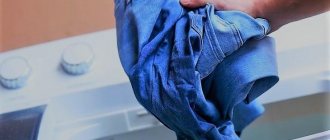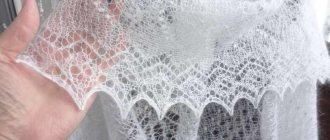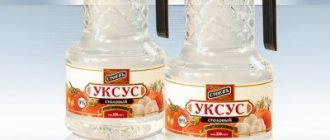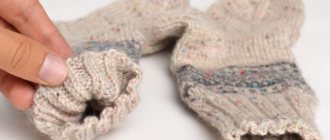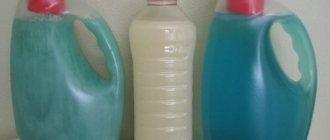How to check color fastness?
Have you purchased a new bright blouse and don’t know whether it fades or not? To avoid any unpleasant surprises when washing your new item, arrange a kind of quality testing for it in one of 3 possible ways.
Option 1
- Wet a small piece of clothing.
- Iron it through the paper.
- If there are stains on the paper, it means the fabric may fade.
- Conclusion - wash it separately from other things.
Important! If you are a fan of bright looks with clothes of various colors, then
How can you tell if the fabric is fading?
To understand that an item is prone to shedding, you can perform two simple tests.
First way to check:
- Wet a small area with warm water.
- Place the product on the ironing board, cover the dampened fabric with a white paper napkin and run a hot iron over it.
- Examine the napkin. If colored spots appear on it, the product is prone to shedding.
The second method of verification is applicable if the manufacturer has sewn a small piece of the fabric from which the clothing is made to the inside of the product.
It is cut off, soaked in a small amount of warm soapy water and the water is inspected after 20 minutes. If the water is stained, the fabric will fade.
How to properly wash things that fade?
In order not to damage your clothes or spoil an expensive or simply beautiful thing, follow the following recommendations:
- Be sure to sort your clothes before washing. Things painted in warm colors (red, burgundy, yellow, orange) should never be mixed with those that have cool shades (green, blue, purple, cyan). Wash black fabric items separately.
- Use exclusively powders for colored fabrics or special gels such as “Perwoll”.
- Wash fading items at a temperature no higher than 30-40 degrees. In an automatic machine, select the mode depending on the type of fabric.
- When washing by hand, put the powder in water, stir and whisk until foam forms. Only then put the clothes on - you need the detergent to completely dissolve, otherwise its grains will discolor areas of the fabric.
- It is forbidden to use soap and soda for washing - they can change the color of the product and disrupt its structure.
- Do not use bleaches for colored fabrics.
- Do not overuse stain removers. Try to remove dirt using available substances (vinegar, lemon, a weak solution of ammonia).
- After washing, rinse items in cool water with vinegar: it will fix and at the same time refresh the color, and the fabric itself will become softer.
How to restore colored items
Not only snow-white items can fade during washing. Sometimes this happens with colored products. This is where some difficulties arise. After all, restoring color to faded colored items is much more difficult than bleaching snow-white fabrics. However, you shouldn't give up. It is quite possible to resurrect a thing.
Ammonia
Peculiarities. Colored items may lose their bright, rich color. After the first wash they look like they are ten years old. To restore the color of a faded item, you need to use ammonia or ammonia.
Washing technology
- 200 ml of ammonia are diluted in five liters of warm water. The drug is taken at 10%.
- Products that have lost their original color are soaked in this solution for one hour.
- Things are thoroughly rinsed and hung to dry.
Chalk
Peculiarities. If it is necessary to update woolen products and restore their color scheme, then you can again turn to folk remedies, such as ordinary chalk.
Washing technology
- A kilogram of chalk is thoroughly crushed.
- The powder is poured into three liters of water.
- The solution is thoroughly stirred.
- The affected items are immersed in the liquid for 30-60 minutes, no more.
- During soaking, the products must be constantly stirred.
- After removing the laundry from the solution, rinse it with cold water.
- The procedure is repeated several times.
- During the last rinse, add a little vinegar to the water. This will give a natural shine to the products. In addition, vinegar “works” as a color fixer.
Dish detergent
Peculiarities. Initially, you should understand that you can save a faded colored item only if the stains are not clearly visible. Minor stains are easily affected by laundry soap. Dishwashing detergent is very effective in removing faded areas.
Washing technology
- The faded stains are rubbed with detergent.
- The product is left in this form for two to three hours.
- Then the things are washed and rinsed well.
You can use special stain removers for colored fabrics. They are marked Color. The following products will effectively remove stains: Vanish color protect, ACE Oxi Magic.
How to wash faded items?
Depending on the type of fabric, to fix or refresh color, remove stains, wash, rinse and dry items, you will need:
- water;
- washing powder for colored items;
- gel for delicate fabrics (“Perwoll”);
- salt;
- 9% vinegar solution;
- turpentine;
- ammonia;
- glycerol;
- mustard powder;
- lemon;
- bran;
- alum;
- tea leaves;
- paper;
- white cotton fabric (sheet, towel);
- bowl or basin;
- iron;
- washing machine.
Important! If you didn't take care of the shedding item and it got into the washing machine tank in some miraculous way, we will help you correct this situation. Follow the link right now and you will learn how to bleach a dyed white item at home.
The dress has faded, what to do at home
A good housewife must know how to wash a faded dress or other item of clothing. Soaking will help you with this matter. Special solutions restore color and return things to their original appearance.
Popular recipes:
- Natural material can be washed repeatedly with powder and salt in hot water;
- Something bad happened, my dress faded, what should I do? The red and white product is rinsed in a soda solution;
- Dark and black things are saved by soaking in water with salt;
- The blue and bright red color is restored by soaking in cold water with the addition of 5 drops of ammonia.
Now you know how to wash a faded dress, as well as what methods to prevent shedding and how to properly wash colored items. If the above tips do not help, you can dye your clothes with a special substance, then rinse and check for shedding.
How to wash faded items?
There are 3 main stages of caring for such fabrics:
- soaking in cold water to pre-fix the color;
- washing separately from all other products;
- rinsing with fixation using special means.
To prevent washing from harming things, do it using one of the following methods.
Method 1
Use salt as a fabric color fixer:
- Pour cold water into the container.
- Add regular table salt in the proportion - 1 tbsp. for 1 liter of water.
- Mix thoroughly.
- Soak the colored item.
- Wait 1 hour.
- Wash with powder by hand or machine.
- Rinse well.
- Dry.
- Iron on the wrong side.
On a note! The method is suitable for things in red, green, blue and black colors - as a rule, they shed most often.
Method 2
Use vinegar to keep things bright:
- Fill a bowl with 8-10 liters of cold water.
- Add 3 tbsp. 9% vinegar solution.
- Immerse clothing in the solution.
- Leave for 10-15 minutes.
- Drain and wash as usual.
- Rinse in lukewarm water, then a couple of times in cold water.
- Squeeze lightly.
- Dry things in the fresh air.
On a note! Thorough rinsing and airing are necessary in order to get rid of the specific sour odor of vinegar essence.
Method 3
Cotton items will not fade if you do this:
- Pour 2 liters of cold water.
- Add 1 tbsp. turpentine.
- Soak the product for 10 minutes.
- Drain the solution.
- Wash clothes in cool water (30 degrees) with powder whipped until foamy.
- Rinse: 1st time - with the addition of 5-10 drops of vinegar, then - in clean water, at the rate of 1 tbsp. l. for 1 liter of water
- Dry thoroughly in fresh air.
On a note! The method is especially effective for washing blue, pink and yellow items. You can take more water, the main thing is to maintain the proportion.
Method 4
Capricious items made from mohair will become soft if you use a separate recipe:
- Pour lukewarm water into a bowl.
- Stir a little gel for delicate fabrics into it.
- Soak things for 10-15 minutes.
- Drain the solution and collect clean water.
- Add 2-3 tbsp per 1 liter. glycerin.
- Pour in the required amount of detergent.
- Wash carefully.
- Rinse.
- Gently squeeze without twisting.
- Dry the items horizontally, laying them on a clean cloth
Important! In another article on our site, we gave even more tips that will help you firmly fix paint on fabric at home. Hurry up to use this information so that any item from your wardrobe will always be in order and ready for your appearance!
How to wash faded items: methods for white items
So, what to do if something fades during washing? It is much easier to deal with stains on white products. But you need to act as soon as the laundry is taken out of the machine and unsightly stains are noticed. Then simply re-washing with bleach may help. To return things to their original snow-whiteness at home, you can go in two ways.
- Soak. Hot water is poured into a large basin and the maximum dose of washing powder is added. To enhance the whitening effect, you can use a chemical bleach (for example, whiteness, Ace, Vanish). Soak laundry in this solution for two to three hours. Then the items are washed by hand. If stains remain, the soaking procedure must be repeated.
- Wash. You can revive faded items using regular washing in a washing machine. The laundry is reloaded into the tank, having first checked that there are no provoking items left. Pour the maximum permissible dose of powder into the detergent compartment. For enhanced whitening, you can add one or two teaspoons of soda ash. Select a high temperature for washing. But this method is only suitable for cotton fabrics.
Other methods of tissue restoration are also known. When choosing the most suitable one, be sure to consider the type of material. The following methods will tell you how to bleach faded white items of various textures.
Digestion
Peculiarities. This method is only suitable for natural fabrics such as cotton or linen. Under no circumstances should you boil down synthetic items. Avoid this method if the product is decorated with lace, guipure or other decorative elements.
Digestion technology
- Pour water into a large saucepan, filling the container halfway. Pour in washing powder at the rate of five liters - a quarter cup. Then add the same amount of bleach and mix thoroughly.
- Place laundry in the solution and turn on the fire.
- During boiling, the laundry is periodically stirred with special tongs. The boiling procedure lasts from 60 to 120 minutes, depending on how much the item has faded.
- After boiling, it is necessary to rinse the laundry with cold water several times.
Washing with homemade stain remover
Peculiarities. To return the product to its snow-white appearance and eliminate stains, you can use traditional methods of cleaning fabrics. A homemade stain remover made from salt, citric acid, starch and brown soap is considered to be quite effective.
Washing technology
- Five liters of hot water are poured into a basin. Add two tablespoons of starch, one tablespoon of salt to the liquid and add 100 g of citric acid.
- Finely grated laundry soap in the amount of two tablespoons is added to the resulting solution.
- The liquid is thoroughly mixed until completely dissolved.
- The laundry is dipped into this solution and left for 12-14 hours.
- After soaking, the product must be rinsed well.
- White clothes are hung out to dry in the scorching rays of the sun. After all, ultraviolet radiation acts on fabric as additional bleaching.
Such a stain remover is effective not only for eliminating the consequences of molting things. It can be used for products that have become grayish or yellow during use.
Soaking with hydrogen peroxide
Peculiarities. Faded items can be bleached using hydrogen peroxide. This product is considered an effective bleach. It is suitable for removing stains from linen and cotton products. Peroxide can be used for delicate items for which aggressive chemicals are contraindicated, for example, for a woolen dress.
Soaking technology
- Four liters of water are poured into a basin. For wool products, the liquid should be lukewarm.
- Add 50 ml of peroxide to the container.
- Next, add a tablespoon of laundry soap shavings.
- Stir the solution thoroughly until it is completely dissolved.
- Carefully lower the products. The soaking process lasts about 10-12 hours. For woolen items, the maximum soaking time is two hours.
- Then rinse the items well in cool water.
Soaking with ammonia
Peculiarities. If you have to restore a delicate jacket or blouse, you can use ammonia. This method is guaranteed to clean stains from a faded product. But it has a significant disadvantage. After soaking, the product will retain the sharp “aroma” of ammonia.
Soaking technology
- Six liters of hot water are poured into the basin.
- Then 100 ml of ammonia is added to it.
- The solution is stirred.
- Faded items are placed in the basin.
- Products must be bleached for two to three hours.
- Things are thoroughly rinsed and hung out to dry.
Washing with potassium permanganate
Peculiarities. As reviews show, potassium permanganate effectively copes with the procedure of bleaching faded white things. A solution of potassium permanganate will not only clean off unnecessary color stains, but will also eliminate a grayish coating that may appear over time.
Washing technology
- Pour half a glass of powder into five liters of hot water.
- Several crystals of potassium permanganate are added to the soap solution.
- It is important that the solution acquires a light pink tint.
- The faded items are immersed in the solution and left for three to four hours.
- Then the things are taken out, washed and rinsed thoroughly.
Whitening with Aspirin
Peculiarities. With the help of Aspirin, you can lighten gray fabrics, eliminate almost all stains and remove even old faded stains. Acetylsalicylic acid can be added to the washing machine as a bleach to the powder. But most often aspirin is used for manual soaking. To ensure better dissolution of tablets in water, it is recommended to use Aspirin C.
Whitening technology
- Ten Aspirin tablets must be carefully crushed.
- The medicinal powder is dissolved in eight liters of water.
- It is important that the solution becomes homogeneous and does not contain undissolved particles.
- The products are loaded into a basin with bleaching liquid and left in it for eight to ten hours.
- After this procedure, things must be rinsed. To facilitate the process, you can use the help of a washing machine by setting the rinse mode.
To effectively remove stains, you can use chlorine-containing bleaches: Belize, Domestos, Ace. In this case, it is recommended to pour one cap of the product into five liters of liquid. If the choice is made on oxygen bleaches, such as Bos, Vanish, Lion Bright, then it is recommended to dilute one spoon of the product in four liters of water.
Useful tips
- For wool clothes, add mustard powder when washing.
- Wash silk products in water where the bran has been previously soaked.
- After rinsing, soak beige, cream or brown clothes in the tea infusion solution for several minutes; depending on the intensity of the color, it should be more or less strong.
- If the pattern on green or black fabric has faded, try refreshing the color by rinsing in an alum solution.
- To remove white stains from deodorant on dark clothes, gently moisten the stained areas with vinegar applied to a cotton pad, then wash the item.
- Wring out the fabrics without twisting them; it is advisable to wrap them in a clean white sheet.
- Dry items in a well-ventilated, shaded place. Remember that direct sunlight will cause bright colors to fade.
- For the same reason, turn everything inside out.
- Dry delicate items and fabrics of combined colors in a horizontal position, laying them out on a towel.
- Iron items that may fade only with an iron with a thermostat.
Important! Maybe,
How to restore the color of clothes?
To restore the color of a fabric
, lost under the influence of any acid, the stain is poured with a small amount of ammonia to neutralize the acid, then moistened with chloroform - and thus the original color will be restored.
A faded green or black pattern is refreshed by rinsing the fabric in an alum solution.
If cotton fabrics (chintz, satin) in blue tones, as well as dark silk, are rinsed after washing in very warm, almost hot salt water (3 tablespoons of salt per 5 liters of water), this will also refresh the colors.
In order for terry towels and
bathrobes to be fluffy after washing
, they must be kept in salted water, rinsed well and not ironed.
Before washing a skirt with a lot of folds
It is recommended to sew with a thin thread with large loose stitches - then it will be easy to iron.
Chemical fiber products
do not rub or twist. They should be washed more often, without waiting for severe contamination.
The laundry will smell nice if you put remnants of toilet soap in the boiling water.
If you are going to dry
washed clothes
in the cold
, add a little vinegar to the rinse water.
The linen will acquire a pleasant shine, and most importantly, it will not freeze to the rope
. You can also wipe the rope itself with a cloth soaked in a warm solution of baking soda or salt.
White
socks and knee socks
can be washed more easily if they are pre-soaked for 1-2 hours in water to which 1-2 tablespoons of boric acid have been added.
To make it easier to wash
handkerchiefs
, pre-soak them for 2 hours in cold salted water.
Secrets of proper soaking of laundry Soak men's shirts made of pure cotton or cotton with the addition of synthetic fibers in advance. But things made of silk and woolen fabrics cannot be soaked.
Soaking laundry in warm water with washing powder or salt promotes better washing and makes it easier.
Do not soak white and colored laundry in the same solution.
Only white laundry can be soaked for a long time (3-4 hours). Colored products with fragile colors and combined ones do not need to be soaked at all.
Pillowcases and duvet covers should be turned inside out before soaking to remove lint and dust from the corners.
New robes and dresses made from printed cotton will
shrink
if they are soaked in
cold salted water
.
Items made from cotton and linen fabrics can be washed using laundry soap and washing soda, and items made from wool, silk and synthetic fabrics can be washed using baby soap and liquid soap. If you add a teaspoon of turpentine to the water, you will need less soap for washing.
Items made of poplin, Damascus, and white piqué can be washed at high temperatures; items made of natural silk, synthetics, and wool cannot be washed.
It is recommended to soak heavily soiled cotton and linen items twice. First, in a lukewarm soapy soda solution (or in a solution of the corresponding washing powder), then the laundry is rinsed and soaked again in the same solution, but at a higher water temperature (up to 40 ° C). After a few hours, the linen is washed and boiled.
Very thin and old items should only be washed by hand.
.
Felted knitwear
Rinse the product in water, to which add 3 tablespoons
of ammonia
for , and leave it in this solution for a day. After this, rinse the product several times in warm water, wrap it in a terry towel, and then dry it by laying it on the table.
After rinsing the wool
and
silk
items in dry cotton fabric (sheet, towel, etc.), and then carefully straighten them out and lay them out to dry.
Products made from staple fabrics
It is not recommended to dry them in the sun - they will lose color.
Thin lace lingerie
Do not fasten with clothespins - it may be damaged at the point of clamping.
Colored clothes lift your spirits and bring bright colors to drab everyday life. But such a wardrobe is difficult to maintain in its original form, because bright dresses, blouses and blouses sometimes fade, which not only makes them pale, but also spoils other things in the washing machine.
Preparation and basic washing rules
Before you send clothes made of black fabric for washing, you need to take a number of steps:
Check pockets for forgotten items (napkins, hairpins, coins).- Turn the product inside out (helps maintain color brightness).
- Carefully study the information on the tag. This is the only way to find out the manufacturer’s recommendations regarding the washing mode, water temperature, permission for the ironing process, and spinning.
- Sort dark laundry by fabric type and degree of soiling.
- Old, stubborn stains from black clothing must be removed before the main wash. It is also prohibited to wash clothes made of different types of fabric (for example, wool and silk) and different colors (white and black) at the same time.
Detergent
How to wash something so it doesn't fade? Detergent will play an important role in this. Among the current abundance, it is very difficult to choose the most suitable one; experts advise adhering to the following criteria:
- so that the fiber does not fade, it is better to give preference to liquid or gel-like, powders will contribute to the release of color;
- universal products will not help preserve the color, the products will gradually fade;
- It’s worth buying several detergents separately, one for white, the second for black, the third for color, each of them will have a special marking;
- It is strictly prohibited to use chlorine-containing bleaches for colors and blacks; they may not be able to remove the stain, but they will definitely remove the color;
- oxygen stain removers are used for clothes that have become dirty only after testing;
Advice! It is better to remove heavy stains using improvised means, having previously tested them on an invisible area. Whatever fabric does not fade during trial processing will not change color when removing dirt.
Do not neglect the choice of detergent; a lot depends on it.
Tips for preserving color on clothing
- There is no need to treat faded fabrics with baking soda.
- Not all items can be machine washed.
- Pay attention to labels before washing brightly colored items for the first time. They contain all the information on caring for the fabric.
- How to find out that an item is fading; the easiest way to find out whether an item is changing color or not is to carefully wipe a small area on the clothing with a damp cloth. If the napkin gets stained, then decide whether to take such a thing or not.
Preserving a bright shade is quite simple, you just need to choose the right method and strictly follow all the instructions. The main thing to remember is that if a thing is painted excessively, then it is the fault of the manufacturers who simply skimped on its quality.

